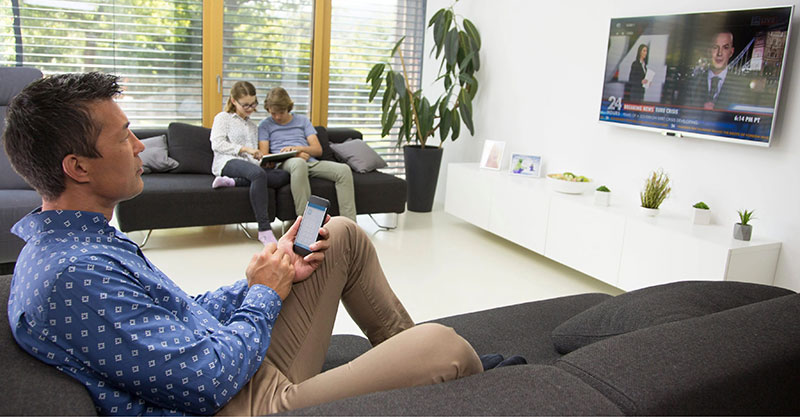Experts from Technicolor’s HERO Partners talk about changes in consumer demands and behaviour leading to new developments that help NSPs maximise their potential this year.

Technicolor Connected Home works with Network Service Providers (NSPs) to help them take advantage of today’s emerging developments needed to deliver connectivity and entertainment experiences to customers.
Through its work in broadband and intelligent Wi-Fi systems, Connected Home supports uninterrupted internet access and interactions, aiming for predictable, consistent content delivery. Their broadband home gateways, for example, are built on open platforms, supporting services that are robust, secure, interoperable and ready to support varied types of applications. Its Wi-Fi systems have a whole-home approach, optimising connectivity and interactions for each user, in all parts of a residence.
With hybrid OTT video set-top-boxes, Technicolor makes TV programming available together with the video content supplied through streaming platforms. Their customers can then build branded UIs, applications and features like voice control, assistants, analytics and IoT integration – meanwhile achieving a fast time to market. Other capabilities range from consumer-focussed UX and product design, to personalised content tools.
Technicolor is an Android TV premier partner and a contributor to RDK, the reference design kit used to develop new video streaming and broadband services, and OpenWrt, an open-source project for embedded Linux operating systems used to route network traffic.
With this foundation, Technicolor Connected Home notes that changed consumer expectations and demands, based on shifting behaviour due to the ongoing COVID-19 crisis, are resulting in new factors for NSPs to address to achieve their goals in 2022. Consequently, NSPs are working on fresh revenue streams and original products for consumers.
For further perspectives on the subject, Technicolor Connected Home asked members of their HERO Partnership Program to share their forecast for 2022 trends. The Program’s partners are developers of innovations that NSPs can use to launch new services, generate growth and stand out from the competition.
The Wi-Fi Way of Life

One of these is Airties, a company that develops smart Wi-Fi systems for service providers. Executive VP and General Manager of their Software Product Line Bart Vercammen said, “We have crossed an inflection point where home Wi-Fi is as vital as electricity for sustaining our way of life – keeping us productive, informed, entertained and connected. Trends like the ‘enterprisation of the home’, remote learning and telemedicine are here to stay, and with that comes significant opportunities and challenges for broadband operators.”
Airties is experiencing greater demand for comprehensive wireless network connectivity throughout residences as more people spend more time at home with more devices than they have before. Airties commissioned a survey that asked 1,500 consumers about home Wi-Fi and found notable themes that may influence NSP strategies in 2022.
“First, 80% of consumers said they would rather their broadband subscription include all of their home Wi-Fi gear -- instead of purchasing anything through retail,” Bart said. “Over half, 58%, said they would consider upgrading to a faster tier of Internet service if their broadband operator offered a premium Wi-Fi system that guaranteed consistent Wi-Fi in every room.”
The Airties survey found that 71% of consumers expect to continue working from home post-pandemic. Also, one third or more of respondents reported they were reimbursed by their employer for new Wi-Fi gear they bought, and 32% indicated that their broadband subscriptions were subsidised by employers.
Using Multicast ABR to Enhance QoE
As direct-to-consumer (DTC) video consumption steadily grew in 2021, NSPs took a harder look at the underlying systems, aiming to support delivery of consistently high-quality content experiences. Damien Sterkers, Video Solutions Marketing Director for Broadpeak, finds that many NSPs will opt for adaptive bitrate (ABR) streaming to replace traditional techniques for broadcasting video – sooner rather than later.

Broadpeak, designer and manufacturer of video delivery components, sees specific interest in multicast ABR methods for optimising streaming performance. “The events of the past two years emphasise the need for collaboration between content providers and Internet Service Providers (ISPs). Together they can ensure that ABR optimisations apply not only to ISP content, but also to any third-party content,” Damien said.
This is a business relationship with great potential for CPE providers, who can now use embedded applications to manage the dynamic selection of the best video delivery path in the network, using multicast ABR when possible. Damien is familiar with this kind of optimisation because Technicolor is currently using, in their own equipment, Broadpeak’s nanoCDN embedded applications in this way.
Noting that Technicolor is among the first CPE providers to understand the opportunities associated with ABR, he said, “They saw that it was necessary to open up the CPE environment to specialised applications, similar to the way Apple opened up their smartphones via the AppStore.
“Each user gets the maximum QoE while optimizing network capacity and costs for the NSP. In 2021, such combinations were adopted by several operators such as TIM in Italy or Megacable in Mexico. In these cases the content provider increases the QoE and the eligibility of its service while the NSP gets more control on the delivery of the 3rd party content, reducing its infrastructure costs.”
Cloud-based Wi-Fi 6 and 6E for Home Networks
Plume operates a cloud-based adaptive WiFi service that monitors all connections on the user’s network. Plume’s Optimizer interprets the data received and applies algorithms that schedule optimisations making sure that each access point on the network makes the best connection possible using the least congested channels. Todd Grantham, CMO for Plume, said that during 2021, heavier usage, load, interference and congestion as a result of work-from-home directives pushed the average number of active users on Plume home networks in the US from 22.6 million prior to the pandemic to 41.1 million in December 2021.
“While widespread broadband network failure didn’t materialize, in-home Wi-Fi networks did feel massive pressure. But due to its proactive nature, Plume’s intelligent platform optimised the changing environments and managed to maintain services,” he said.
Moving into 2022, high levels of work-from-home activity continue, combined with the introduction of more devices and new Wi-Fi generations including Wi-Fi 6 and Wi-Fi 6E, which increase management complexity. In April 2021, 50 percent of Plume homes in the US had 19 devices or more connected to wireless networks, up 27 percent in 2020.

“Throughout 2022, we believe that service providers who move beyond speed and price by using new services and experiences to support evolving customer needs will be truly successful – and that can only be achieved through the speed, flexibility and power of the cloud,” said Todd.
Smart Security to Handle New Threats
Ongoing efforts to support working from home has attracted unwelcome attention from malware developers and other negative influences targeting the connected home environment. As a result, users are beginning to expect NSPs to create stable, secure broadband access and digital services. Security service provider CUJO AI has introduced connected device identification, real-time network security, privacy protection, content access control and digital monitoring via Technicolor Connected Home CPE.
Einaras von Gravrock, CUJO AI’s CEO of Security, said, “As smart home device penetration continued to grow, so did the impact of their security issues, putting pressure on NSPs to include simple personalised, security experiences within the home network.” Securing smart and IoT devices is one of CUJO AI’s areas of expertise. Their internal research indicates that malicious actors are targeting residential endpoints more often, seeking private data that may be located in NAS devices, and that about one quarter of all malicious remote access attempts target NAS resources.
CUJO AI’s own AI engine is a set of machine learning algorithms that can detect, recognise and classify connected devices, application usage and web content, security threats and privacy risks from huge amounts of network data. The Engine works with an Agent that monitors data and enforces policy at specific points in the network, and with a Cloud component that processes and stores collected data.
“New security, phishing and remote access threats are discovered every day, and NSPs will continue feeling pressure to take care of subscriber security,” Einares said. “Therefore, CUJO AI’s work with Technicolor Connected Home has focussed on enabling operators and their customers to take advantage of new developments capable of protecting against evolving security challenges.”
Programmatic Advertising and NSP Monetization

Hoppr is an advertising developer that connects consumers to advertising agencies and brands through NSPs in an accurate, targeted manner. Hoppr’s CEO Cyril Daoud commented that wide Smart TV adoption, combined with consumers spending more time online at home in 2021, has created an opportunity for NSPs to explore how advertising strategies can affect profitability.
At the same time, Technicolor Connected Home with its experience in deploying intelligent CPE supporting video and gaming experiences, finds that not all of the OTT video services that consumers now access on a regular basis are paid-for subscription video on demand. Consumers are also taking increasing advantage of advertising video on demand (AVOD) supported services.
“Hoppr is working to integrate its ad platform onto Technicolor Connected Home’s set-top boxes to support operators that want to deliver digital advertising in new formats to subscribers. For instance, Hoppr and Connected Home are making it possible for operators to monetise ‘in-between-moments’ while viewers are searching for their next entertainment,” said Cyril. www.technicolor.com/connect




